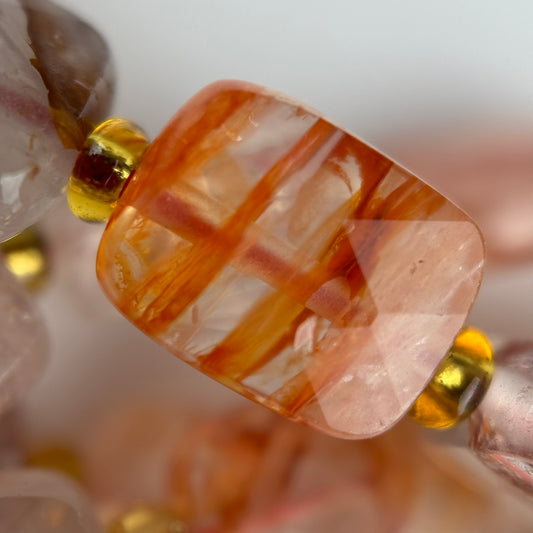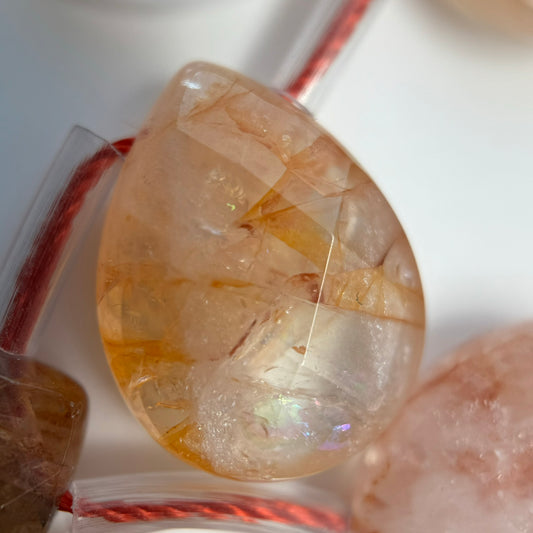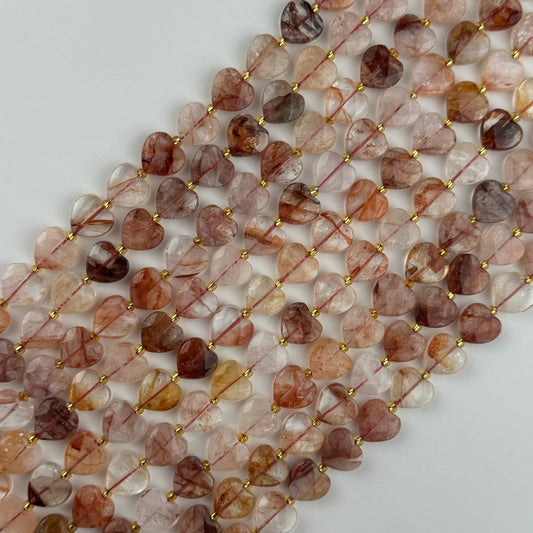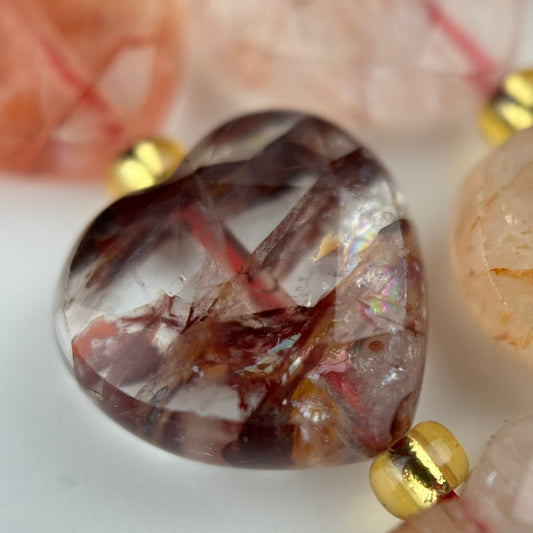Hematoid Gemstone Beads
Exploring Hematoid Quartz Gemstone Beads
Hematoid Quartz, also known as Hematoid or Red Quartz, is a variety of quartz containing inclusions of hematite that create distinctive red, orange, or brown patterns. These inclusions form during crystal growth, creating unique visual effects that make each bead individual.
Unique Characteristics
- Red, orange, or brown hematite inclusions
- Transparent to translucent quartz base
- Pattern variations in each specimen
- Mohs hardness of 7
- Combination of quartz clarity and hematite color
Mineralogical Composition and Inclusions
Hematoid Quartz consists of silicon dioxide (SiO2) with hematite (Fe2O3) inclusions distributed throughout the crystal structure. These inclusions form as the quartz crystal grows, trapping hematite particles.
Composition Details
- Base mineral: Quartz (SiO2)
- Inclusions: Hematite (Fe2O3)
- Crystal system: Trigonal
- Specific gravity: 2.65-2.80
- Refractive index: 1.544-1.553
Formation and Geological Processes
Hematoid Quartz forms when quartz crystals grow in environments rich in iron oxide. The hematite inclusions become trapped during crystal formation, creating the characteristic patterns.
Formation Conditions
- Hydrothermal environments with iron-rich solutions
- Quartz veins with hematite deposits
- Temperature range: 100-300°C
- Iron oxide availability during crystallization
- Slow crystal growth allowing inclusion capture
Inclusion Patterns and Visual Appeal
The hematite inclusions create various patterns that enhance the stone's visual interest. These patterns range from fine dust-like particles to larger flakes and streaks.
Pattern Types
- Fine hematite dust creating overall color
- Larger flakes creating spotted patterns
- Streaks and bands of hematite
- Cloud-like inclusions
- Combination patterns
Color Variations and Intensity
Hematoid Quartz displays a range of colors depending on the concentration and distribution of hematite inclusions, from pale pinkish-red to deep reddish-brown.
Color Spectrum
- Pale pinkish-red with light inclusions
- Medium red-orange tones
- Deep reddish-brown
- Orange-brown variations
- Color intensity varies with inclusion density
Cutting and Enhancement Techniques
Proper cutting maximizes the visual appeal of hematite inclusions while maintaining the quartz's transparency. Orientation affects how inclusions are displayed.
Cutting Considerations
- Faceted cuts showcase inclusions
- Cabochon cuts for uniform color
- Bead shapes: round, oval, faceted
- Orientation affects inclusion visibility
- Polish enhances transparency
Hardness and Durability Properties
With a Mohs hardness of 7, Hematoid Quartz offers good durability for jewelry use. The quartz base provides stability while inclusions don't significantly affect durability.
Durability Aspects
- Mohs hardness: 7 (quartz standard)
- Good resistance to scratching
- Stable under normal conditions
- No cleavage planes
- Suitable for everyday wear
Geographic Sources and Availability
Hematoid Quartz occurs in various locations worldwide, with notable sources in Brazil, Madagascar, and other quartz-producing regions.
Primary Sources
- Brazil: High-quality material with good color
- Madagascar: Fine specimens available
- Various quartz-producing regions
- Hydrothermal vein deposits
- Commercial availability varies
Care and Maintenance Practices
Hematoid Quartz requires standard quartz care practices. The hematite inclusions are stable and don't require special treatment.
Care Guidelines
- Clean with warm soapy water
- Soft brush for detailed cleaning
- Ultrasonic cleaning generally safe
- Store separately to prevent scratching
- Standard jewelry care practices
Jewelry Design Possibilities
Hematoid Quartz beads offer unique design opportunities, combining the clarity of quartz with the warm colors of hematite inclusions.
Design Applications
- Strand necklaces showcasing color
- Bracelets with uniform beads
- Mixed designs with complementary stones
- Focal beads in jewelry pieces
- Contemporary and traditional styles
Metaphysical Associations and Meaning
Hematoid Quartz combines properties attributed to both quartz and hematite, creating associations with grounding, clarity, and energy balance.
Symbolic Properties
- Combination of clarity and grounding
- Energy balancing properties
- Emotional stability
- Connection to earth energy
- Enhanced focus and concentration
Comparison with Related Quartz Varieties
Hematoid Quartz belongs to the included quartz family, sharing characteristics with other varieties while maintaining its unique appearance.
Related Varieties
- Rutilated Quartz: Golden needle inclusions
- Tourmalinated Quartz: Black tourmaline inclusions
- Chlorite Quartz: Green chlorite inclusions
- Clear Quartz: No inclusions
- Each variety has distinct characteristics
Frequently Asked Questions
What is the mineralogical composition and relationship of Hematoid Quartz to Hematite?
Hematoid Quartz is a variety of quartz (SiO2) that contains inclusions of Hematite (Fe2O3). The Hematite forms as microscopic platelets or needle-like inclusions within the quartz crystal structure, creating the characteristic red, orange, or brown coloration and metallic reflections.
What causes the red and orange coloration in Hematoid Quartz beads?
The coloration in Hematoid Quartz comes from Hematite inclusions that are distributed throughout the quartz matrix. These iron oxide inclusions absorb certain wavelengths of light and reflect others, creating the red, orange, or brown hues. The intensity of color depends on the concentration and distribution of Hematite particles.
What is the Mohs hardness and how does it compare to pure Quartz?
Hematoid Quartz maintains the same Mohs hardness as pure quartz, which is 7. The Hematite inclusions do not significantly affect the overall hardness, making Hematoid Quartz beads durable for jewelry use. However, the inclusions may create planes of weakness that could affect toughness.
How do Hematite inclusions affect the optical properties of Hematoid Quartz beads?
Hematite inclusions create unique optical effects including metallic reflections, asterism (star effect) in some specimens, and color zoning. The inclusions scatter light differently than pure quartz, creating depth and visual interest. Under magnification, the Hematite platelets can be seen as reflective particles.
What is the formation process that creates Hematoid Quartz?
Hematoid Quartz forms when Hematite precipitates within growing quartz crystals, typically in hydrothermal environments or during the crystallization of quartz from silica-rich solutions containing dissolved iron. The Hematite can form simultaneously with the quartz or be deposited later in fractures and inclusions.
What are the primary geological sources of Hematoid Quartz gemstone?
Significant sources of Hematoid Quartz include Brazil (particularly Minas Gerais), Madagascar, India, and some locations in the United States. Brazilian material is often highly valued for its rich coloration and clarity. The quality varies significantly by locality.
How does the specific gravity of Hematoid Quartz compare to other quartz varieties?
Hematoid Quartz has a specific gravity slightly higher than pure quartz (2.65) due to the denser Hematite inclusions (SG 5.0-5.3). Typical values range from 2.66 to 2.68, depending on the concentration of Hematite inclusions. This slight increase is usually not noticeable in beads.
What is the difference between Hematoid Quartz and other iron-stained quartz varieties?
Hematoid Quartz contains actual Hematite mineral inclusions, while iron-stained quartz may have surface staining or iron oxide coatings. True Hematoid Quartz shows Hematite particles within the crystal structure, creating internal reflections and metallic flashes, not just surface coloration.
How do gemologists identify and verify authentic Hematoid Quartz beads?
Gemologists use magnification to observe Hematite inclusions, test for quartz properties (hardness 7, specific gravity ~2.66), and examine the distribution of inclusions. Authentic Hematoid Quartz shows Hematite particles throughout the material, not just on the surface. Advanced testing may include X-ray diffraction or spectroscopy.
What cutting and polishing considerations are important for Hematoid Quartz beads?
Cutters must orient Hematoid Quartz to maximize the display of Hematite inclusions and their reflective properties. Polishing requires care to avoid removing surface material that contains inclusions. The material polishes well but may show variations in luster depending on the density of inclusions in different areas.
Can Hematoid Quartz beads exhibit asterism or other optical phenomena?
Yes, some Hematoid Quartz specimens can exhibit asterism (star effect) when Hematite inclusions are aligned in specific patterns. This creates a star-like reflection when viewed under a single light source. Chatoyancy (cat's eye effect) is also possible in some specimens with parallel-oriented inclusions.
How do the Hematite inclusions affect the durability of Hematoid Quartz beads?
The Hematite inclusions can create planes of weakness within the quartz structure, potentially making the material slightly more prone to fracturing than pure quartz. However, the overall durability remains good due to quartz's hardness of 7. Care should be taken to avoid impacts that could cause cleavage along inclusion planes.
What causes the variation in color intensity among different Hematoid Quartz beads?
Color intensity varies based on the concentration, size, and distribution of Hematite inclusions. Higher concentrations create deeper red or orange colors, while sparse inclusions result in lighter, more subtle coloration. The orientation of inclusions relative to the cut surface also affects how the color appears.
How should Hematoid Quartz beads be cleaned and maintained?
Clean Hematoid Quartz beads with warm, soapy water and a soft brush, avoiding harsh chemicals that could affect the Hematite inclusions. Ultrasonic cleaning should be used cautiously as vibrations might cause fracturing along inclusion planes. Store separately from harder materials to prevent scratching.
What makes Hematoid Quartz beads unique compared to other colored quartz varieties?
Hematoid Quartz is unique because its color comes from actual mineral inclusions (Hematite) rather than trace elements in the crystal structure or surface treatments. This creates distinctive metallic reflections, depth, and natural color variations that cannot be replicated through artificial means, making each bead truly unique.









